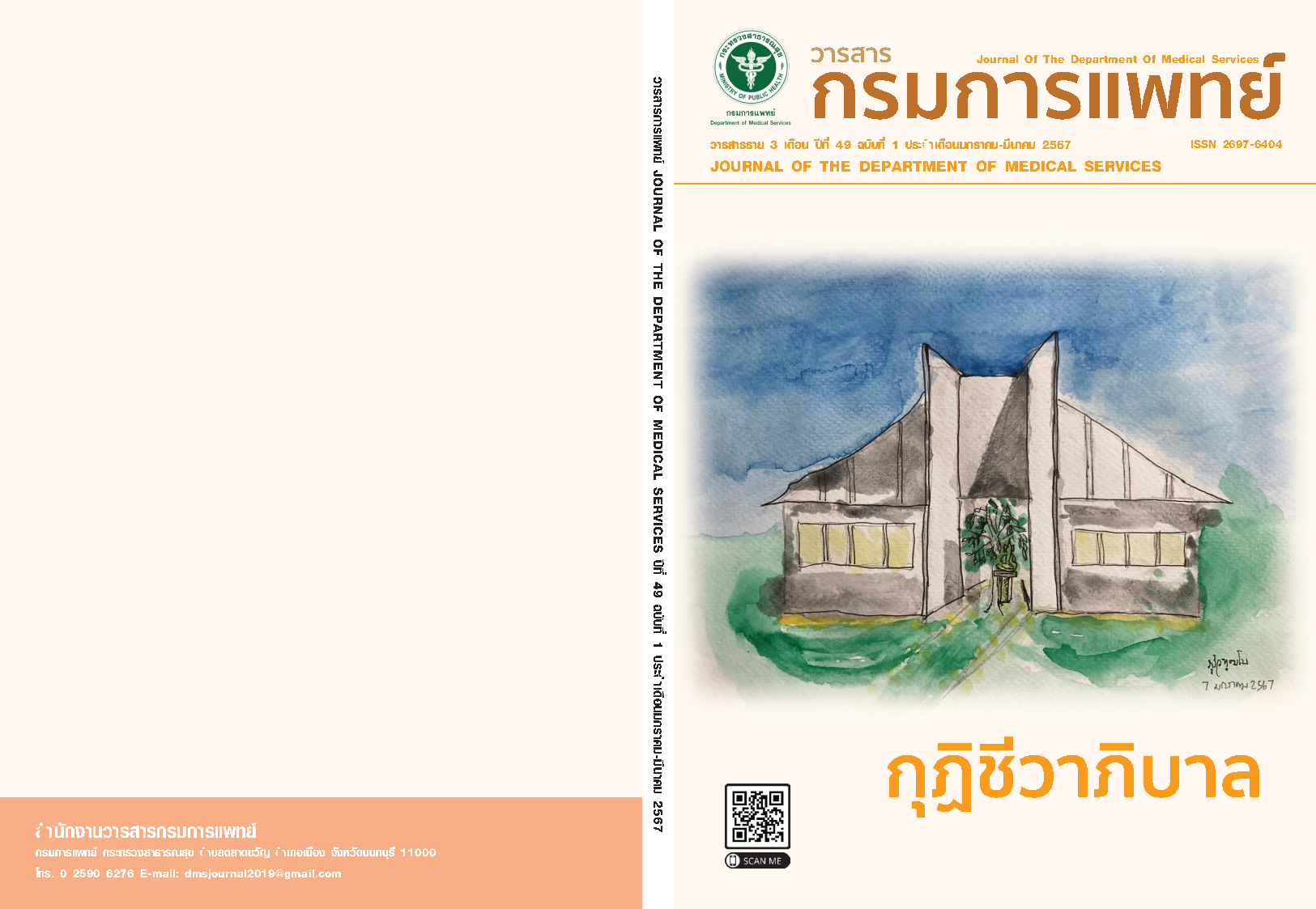The Development of Clinical Nursing Practice Guideline for Prevention and Reduction of Hypersensitivity Reaction Severity in Breast Cancer Patients undergoing Chemotherapy Taxane Regimen
Keywords:
Clinical Nursing Practice Guideline (CNPG), Breast cancer, Chemotherapy, Hypersensitivity reactionAbstract
Background: Hypersensitivity reaction is an important risk to monitor in cancer patients undergoing chemotherapy. Patients should receive proper and timely assessment and management of hypersensitivity reaction to ensure their safety. Objective: This study aimed to develop a clinical nursing practice guideline (CNPG) for the prevention and reduction of hypersensitivity severity in breast cancer patients receiving Taxane chemotherapy. Method: The study applied the clinical practice guideline development model of National Health and Medical Research Council of Australia 1999 and the Department of Nursing at Chulalongkorn Hospital Thai Red Cross Society in 2019. Collecting empirical evidence and assessing the level of credibility, comprising 29 research studies and 4 related guidelines, a total of 33 topics were extracted to develop evidence-based nursing practices. The CNPG was developed through a review process by 4 experts. The overall score on the AGREE II assessment form was 87.2 and was revised to ensure appropriateness. The CNPG was then trialed with 2 sample groups: 10 nurses’ chemotherapy and 31 breast cancer patients receiving taxane chemotherapy. Results: The synthesis of the results for creating CNPG included the following components: 1) Patient care before receiving chemotherapy by assessing readiness to receive chemotherapy and risk factors for hypersensitivity, 2) Patient care during chemotherapy, including drug administration methods, premedication, surveillance for signs and symptoms, and managing hypersensitivity reactions, and 3) Post-chemotherapy patient care, including assessing complications and providing advice and guidance. When trialed with a sample group was found that expressed satisfaction level was high in the nurse’s group (mean = 4.10, SD = 0.32). The highest level of satisfaction was clarity and the ability to practicality (mean = 4.60, SD = 0.52). While hypersensitivity severity was found in 1 patient (3.2%), mild (grade 2) severity, which could be resolved and continued chemotherapy. Conclusion: The CNPG should be implemented throughout the organization.
References
Rojanamatin J, Ukranun W, Suppattagorn P, Chaiwiriyabunya I, Wongsena M, Chaiwerawattana A. Cancer in Thailand Vol.X, 2016-2018. Bangkok: National Cancer Institute; 2021.
Pongnikorn D, Daoprasert K, Wongkeaw B, Sangkham S, Praditkai M. Trends in cancer incidence and mortality in northern, Thailand, 1993-2017. Lampang: Lampang Cancer Hospital; 2020.
Imsomran W, Chaiwerawattana A, Manorom D, Thanasittichai S. Guidelines for screening, diagnosis and treatment of breast cancer. Bangkok: National Cancer Institute; 2017.
Jhankumpha S, Sareelae N, Sararat C, Kumdang S, Panawong S. Factors related to hypersensitivity reactions of cancer patients with receiving Paclitaxel Chemotherapy. Nursing, Health, and Education Journal 2019;2(3):43-54.
Subongkod S, Yoodee J, Sanguanboonyaphong P. Drug Monograph. In: Subongkod S, Yoodee J, Sanguanboonyaphong P, editors. Standards work instruction for chemotherapy drugs and post chemotherapy care. Bangkok: National Cancer Institute; 2017. p. 278-80.
Wongjunlongsin S, Sumdaengrit B. Symptom cluster in breast cancer patients receiving Chemotherapy: A longitudinal study approach. Journal of Nursing and Health Care 2015;33(2):122-31.
Foongfaung S. Nursing management of hypersensitivity and infusion reactions from intravenously administered Chemotherapeutic agents. Thai Cancer Journal 2018; 38(1):29-41.
Loissaratrakul N, Udomphol N, Panna P. Incidence and Risk Factors for Paclitaxel Hypersensitivity in Cancer Chemotherapy. Thai Cancer Journal 2019;39(4):143-52.
Thangwonglers T, Santimaleeworagun W, Therasakvichya S, Saengsukkasemsak N, Pimsi P. Characteristics of immediate hypersensitivity reaction to Paclitaxel - based chemotherapy in gynecologic cancer patients. Asian Pacific J Allergy Immunol 2020.
National Cancer Institute of the National Institutes of Health US. Common Terminology Criteria for Adverse Events (CTCAE) Version 5.0. [Internet]. 2017 [cited 2021 Nov 19]. Available from: https://ctep. cancer.gov/protocoldevelopment/electronic_ applications/docs/ctcae_v5_quick_reference_5x7.pdf.
Tewichai S. Epidemiology of Hypersensitivity reactions induced by Paclitaxel in Lampang Cancer Hospital in 2013-2015. [Internet]. Lampang: Lampang Cancer Hospital; 2017 [cited 2021 Aug 20]. Available from: https://www.lpch.go.th/km/uploads/201701 25143113365781.pdf.
Boulanger J, Boursiquot JN, Cournoyer G, Lemieux J, Masse MS, Almanric K, et al. Management of hypersensitivity to platinum- and taxane-based chemotherapy : CEPO review and clinical recommendations. Curr Oncol 2014;21(4):e630-41.
Ishida S, Masuguchi K, Kawashiri T, Tsuji T, Watanabe H, Akiyoshi S, et al. Effects of diluent volume and administration time on the incidence of Anaphylaxis following Docetaxel Therapy in breast cancer. Biol Pharm Bull 2020;43(4):663-8.
Moungmultri A, Kotano S. The effect of the development a nursing practice for cancer patients to prevent hypersensitivity reaction from chemotherapy in daycare chemotherapy center at Roi ET Hospital. Journal of Research and Health Innovative Development 2020;1(2):115-22.
Khamsopa N, Hongthai S. A comparative study of hypersensitivity reaction between slow rate infusion and usual rate in cancer patients receiving Taxanes. CHJ 2018;4(1):75-82.
Narksanong S. Effectiveness of the first-hour Paclitaxel administration to reduce the incidence of hypersensitivity reactions in cancer patients at Uttaradit Hospital. Health Science Clinical Research 2020;35(2):45-56.
Puanfai K, Suwankruhasn N, Tantiwut K. Factors related to paclitaxel hypersensitivity among lung cancer patients receiving chemotherapy at outpatient chemotherapy unit 1 Maharaj Nakorn Chiang Mai Hospital. Nursing Journal CMU 2022;49 (1):238-51.
National Health and Medical Research Council (NMRC). A guide to the developmental, implementationand evaluation of clinical practice guidelines. Australia: NMRC; 1999.
Saengsiri A, Jidapern W. Evidence based clinical nursing practice guideline Chula Thai red cross model. Bangkok: Boonsiri printing; 2019.
EBSCO Health. Evidence-based nursing practice: 7 Steps to the Perfect PICO Search. [Internet]. 2023; [cited 2023 May 20]. Available from: https://www.ebsco. com/sites/g/files/ nabnos191/files/acquiadam-assets/ 7-Steps-to-the-Perfect-PICO-Search-White-Paper TH.pdf
Melnyk BM, Fineout-Overholt E. Evidence basedpractice in nursing & healthcare: A Guide to Best Practice. US: Lippincott Williams & Wilkins; 2011.
Institute of Medical Research and Technology Assessment, Department of Medical services. Appraisal of Guideline for Research & Evaluation II; AGREE II (Thai version). Nonthaburi: Ministry of Public Health; 2013.
Downloads
Published
How to Cite
Issue
Section
License
Copyright (c) 2024 Department of Medical Services, Ministry of Public Health

This work is licensed under a Creative Commons Attribution-NonCommercial-NoDerivatives 4.0 International License.
บทความที่ได้รับการตีพิมพ์เป็นลิขสิทธิ์ของกรมการแพทย์ กระทรวงสาธารณสุข
ข้อความและข้อคิดเห็นต่างๆ เป็นของผู้เขียนบทความ ไม่ใช่ความเห็นของกองบรรณาธิการหรือของวารสารกรมการแพทย์


